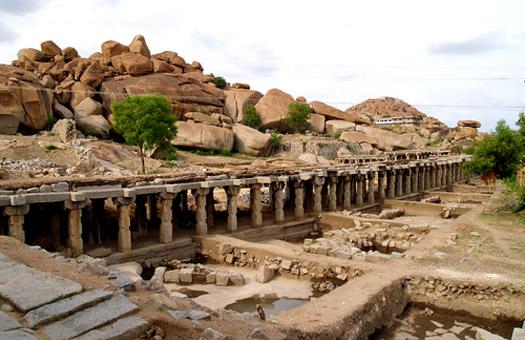VIJAYANAGAR EMPIRE
| |
- Several theories have been projected claiming the basis of the Vijayanagar Empire. A few assert that Harihara I and Bukka Raya I, the originators of the kingdom, were the ones primarily allied to the Kakatiya. Prior to the premature 14th century augment of the Vijayanagara empire, the Hindu realms of the Deccan, the Seuna Yadavas of Devagiri, the Kakatiya dynasty of Warangal, the Pandya Kingdom of Madurai, and the insignificant kingdom of Kampili were continually marched into by Muslims from the north, and by 1336 had been overpowered by Alla-ud-din Khilji and Muhammad bin Tughluq, the Sultans of Delhi. The Hoysala Empire was the solitary enduring Hindu kingdom in the path of the Muslim invasion. After the demise of Hoysala Veera Ballala III during a skirmish in opposition to the Sultan of Madurai in 1343, the Hoysala Empire compound with the mounting Vijayanagar Empire.
- Travelers such as Domingo Paes, Fernao Nuniz and Niccolò Da Conti endow with significant information regarding the region`s history. Archaeological excavations at Vijayanagara have exposed the kingdom`s riches and authority. Several tombstones fanned out across South India, the finest known- the assemblage at Hampi are the realm`s inheritance.
- During this period only the temple construction ethnicity in South India was founded by the Architecture manner. The blend of all convictions and dialects enthused architectural advance of Hindu temple creation, foremost in the Deccan and shortly in the Dravidian expressions using the local granite. The Secular royal structures show the influence of the Northern Deccan Sultanate architecture and competent management along with dynamic overseas trade introduced innovative expertise like water management systems for irrigation.
|
The Vijayanagara Empire`s support facilitated fine arts and literature in order to attain new-fangled pinnacles in the languages of Kannada, Telugu, Tamil and Sanskrit, while Carnatic Music advanced into its existing structure. The Vijayanagar Empire shaped an era in South Indian history thereby surpassing regionalism with the promotion of Hinduism as a coalescing feature. Trade and commerce were carried vigorously which brought about new ideas and a multitude of changes in the kingdom. Irrigation and water management systems were enhanced and developed during the Vijayanagara dynasty.
Languages like Telugu, Tamil, Kannada and Sanskrit developed and literature reached new heights. Carnatic music, South Indian classical music were developed tremendously and achieved its current form. The kingdom created an era where Hinduism was a unifying factor and went beyond all boundaries of language and beliefs.
|
The Vijayanagar Empire was famous for its rich heritage and beautifully constructed monuments that were spread over Southern India. The rich cultural heritage of South India was the main inspiration for temple architectural styles. The construction style of Hindu temples was inspired from the blending of different faiths and languages. Local granite was used in building temples first in the Deccan region and then in the Dravidian regions. The rulers of the Vijayanagar Empire were admirers of fine arts and encouraged people to indulge themselves in music, dance and handicrafts.
Vijayanagara rulers celebrated the Dussehra festival with much devotion when the king sat on his bejeweled throne in the center of Mahanavami Dibba, a decorated platform, and watched a colourful procession pass by. The place is worth a visit as the sides of the platform still retain the beautiful sculptures depicting many soldiers, dancers and an array on animals. Water tanks and channels abound in Hampi.
The most ornate of them all is the Queen’s bath located in the citadel area, south of the Ramachandran temple. The temple itself is in the royal enclosure of the capital. It was perhaps the king’s private shrine and contains some exceptional carvings and murals both within and on the outer walls. The outer friezes shown horses, elephants, dancing girls and infantry in procession, while the inner panels depict individual deities or scenes from the Ramayana.
|
For 200 years the Vijayanagar Empire emerged as one of the most powerful kingdoms in the Peninsular India. The empire was so strong that four Muslim kingdoms had to come together to destroy this strong kingdom. The ruins of this great kingdom can be seen even today at Hampi which has been declared a protected site by the UNESCO.
| ||||
Vijay Nagar kingdom emergence:
Vijay Nagar Kingdom and the city was founded by Harihar-I and Bukka-I (Sons of Sangama). Harihar and Bukka were brought to the centre by Mohammed-bin-Tuglaq, converted to Islam and were sent to south again to control rebellion. Harihara and Bukka founded the Vijayanagar Empire in 1336 on the advice of Vidyaranya.
Vijayanagar's arch rival was bahmani with home it fought over Tungabhadra doab (between Krishna and Krishna-Godavari delta) and Marathwada. Vijayanagar-Bahmani contest was started by Bukkar I in 1367 when he attacked the Bahmain fortress at Mudkal. Vijayanagar was told by following four dynasties.
- The Sangam dynasty (1336-1485)
- First Usurpation: The Saluva dynasty (1485-1505)
- Second Usurpation: The Tuluvu dynasty
- Third Usurpation: The Aravidu dynasty
Reasons For Growth Of Vijayanagar Empire
|
|
No comments:
Post a Comment